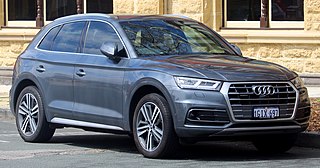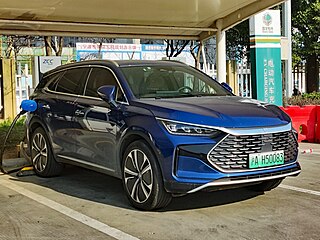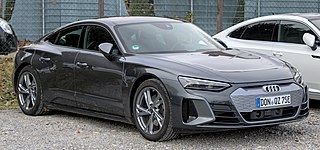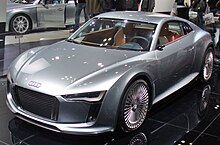
The Audi A3 is a subcompact executive/small family car (C-segment) manufactured and marketed by the German automaker Audi AG since September 1996, currently in its fourth generation.

The Toyota RAV4 EV is an all-electric version of the popular RAV4 SUV produced by Toyota until 2014. Two generations of the EV model were sold in California, and to fleets elsewhere in the US, with a gap of almost ten years between them.

The Audi Q7 is a crossover SUV made by the German manufacturer Audi, unveiled in September 2005 at the Frankfurt Motor Show. Production of this seven-seater SUV began in the autumn of 2005 at the Volkswagen Bratislava Plant in Bratislava, Slovakia.

BYD Auto Co., Ltd. is the automotive subsidiary of the publicly listed Chinese multinational manufacturer BYD Company, headquartered in Xi'an, Shaanxi Province, China. It was founded in January 2003, following BYD Company's acquisition of Qinchuan Automobile Company in 2002. The company produces passenger cars, buses, trucks, electric bicycles, forklifts, and rechargeable batteries. The current model range of automobiles includes battery electric vehicles (BEVs) and plug-in hybrid electric vehicles (PHEVs), and the company also produced petrol engine vehicles up until March 2022.

The Audi Q5 is a series of compact luxury crossover SUVs produced by the German luxury car manufacturer Audi from 2008. The original first-generation model was the third member of the B8 family to be released after the Audi A5 and fourth-generation A4, all being based on the Audi MLB platform. The second generation Q5 debuted in 2016 and shares the Audi MLB Evo platform with the corresponding B9 versions of the A4 and A5.

The history of plug-in hybrid electric vehicles (PHEVs) spans a little more than a century, but most of the significant commercial developments have taken place after 2002. The revival of interest in this automotive technology together with all-electric cars is due to advances in battery and power management technologies, and concerns about increasingly volatile oil prices and supply disruption, and also the need to reduce greenhouse gas emissions. Between 2003 and 2010 most PHEVs on the roads were conversions of production hybrid electric vehicles, and the most prominent PHEVs were aftermarket conversions of 2004 or later Toyota Prius, which have had plug-in charging and more lead-acid batteries added and their electric-only range extended.

Audi hybrid vehicles are hybrid electric vehicles created by the German carmaker, Audi. Some vehicles listed were concept vehicles, which utilised an internal combustion engine and an electric motor, and were used for research and development (R&D) for potential future use of the technology into possible series production. Audi launched its first hybrid concept car in 1989 called the Audi Duo, and was the first European company to sell a hybrid in 1997, though only in very small numbers.

The BMW i8 is a plug-in hybrid sports car developed by BMW. The i8 was part of BMW's electrified fleet and was marketed under the BMW i sub-brand. The production version of the BMW i8 was unveiled at the 2013 Frankfurt Motor Show and was released in Germany in June 2014. Deliveries to retail customers in the U.S. began in August 2014. A roadster variant was launched in May 2018. Production ended in June 2020.

The Tesla Model X is a battery electric mid-size luxury crossover SUV produced by Tesla, Inc. since 2015. Developed from the full-sized sedan platform of the Tesla Model S, the vehicle notably uses falcon wing doors for passenger access.

The BYD Tang is a crossover SUV manufactured by BYD Auto, available as an all-electric vehicle, a plug-in hybrid or a conventional ICE vehicle. The vehicle is the second model of BYD's "Dynasty" series passenger vehicles, and gets its name from the Tang dynasty, the most prosperous of all the great Chinese dynasties.

The Kia Niro is a compact crossover SUV (C-segment) manufactured by Kia since 2016. It is an electrification-focused vehicle, offering three versions: hybrid, plug-in hybrid and battery electric variants.

Mercedes-EQ is a series of battery electric vehicles manufactured by Mercedes-Benz. The first model was previewed at the Paris Motor Show in 2016 with the Generation EQ concept vehicle. Mercedes-Benz intends to produce ten EQ models by 2022, three of which will have the Smart brand, representing between 15% and 25% of the company's global sales. All of Mercedes-Benz electric vehicle design and production efforts will target the EQ family.

The Audi Q8 is a mid-size luxury crossover SUV coupé made by Audi that was launched in 2018. It is the flagship of the Audi SUV line, and is being produced at the Volkswagen Bratislava Plant.

The Volkswagen Group MEB platform is a modular car platform for electric cars developed by the Volkswagen Group and its subsidiaries. It is used in models of Audi, SEAT, Škoda and Volkswagen, along with Ford through partnership. The architecture is aimed to "consolidate electronic controls and reduce the number of microprocessors, advance the application of new driver-assistance technology and somewhat alter the way cars are built" by the VW Group.
Pakistan already has a significant market for hybrid vehicles with Honda's Vezel, Toyota's Prius, and Aqua, and other models seen on the roads. The Automotive Development Policy (2016–2021) and the launch of the China-Pakistan Economic Corridor (CPEC) are encouraging foreign investments for new automobile brands to enter Pakistani market, while the leading manufacturers in the automobile industry in Pakistan are interested in introducing electric vehicle (EV) models with a wide range of prices which target consumers of diverse income groups. Several members of the international automobile industry including South Korea, China, and Japan also believe that Pakistan has a high potential market for EV technology, and local businesses are collaborating with them to bring EVs to Pakistan.

The Audi Q8 e-tron is a battery electric mid-size luxury crossover produced by Audi since 2019. The e-tron was unveiled as a concept car at the 2015 Frankfurt Motor Show. The final production version was revealed in San Francisco on 17 September 2018, publicly debuted at the 2018 Paris Motor Show, and was first delivered in May 2019. It is the company's first battery electric mass production car. The Sportback variant, a coupe style of the e-tron, entered production in 2020.

The Audi Q4 e-tron is a battery electric compact luxury crossover SUV produced by Audi. It is based on Volkswagen Group's electric MEB platform and is the fourth fully-electric model in the Audi e-tron series after the Audi Q8 e-tron, e-tron GT and Q2L e-tron. Production began in March 2021, with the production version being unveiled in April 2021.

The Volkswagen ID.4 and Volkswagen ID.5 are battery electric compact crossover SUVs produced by Volkswagen. Based on the MEB platform, the ID.4 is the second model of the Volkswagen ID. series. The production version of the ID.4 debuted in September 2020 as the first fully-electric crossover SUV under the Volkswagen brand, while the coupe-shaped variant of the ID.4 is marketed as the Volkswagen ID.5 and was revealed in November 2021.

The Audi e-tron GT is a battery electric executive car produced by Audi since late 2020 as part of the e-tron battery electric sub-brand, and the third fully electric car model, after e-tron and e-tron Sportback SUVs. Based on the J1 platform shared with the Porsche Taycan, the car went on sale in March 2021.




























